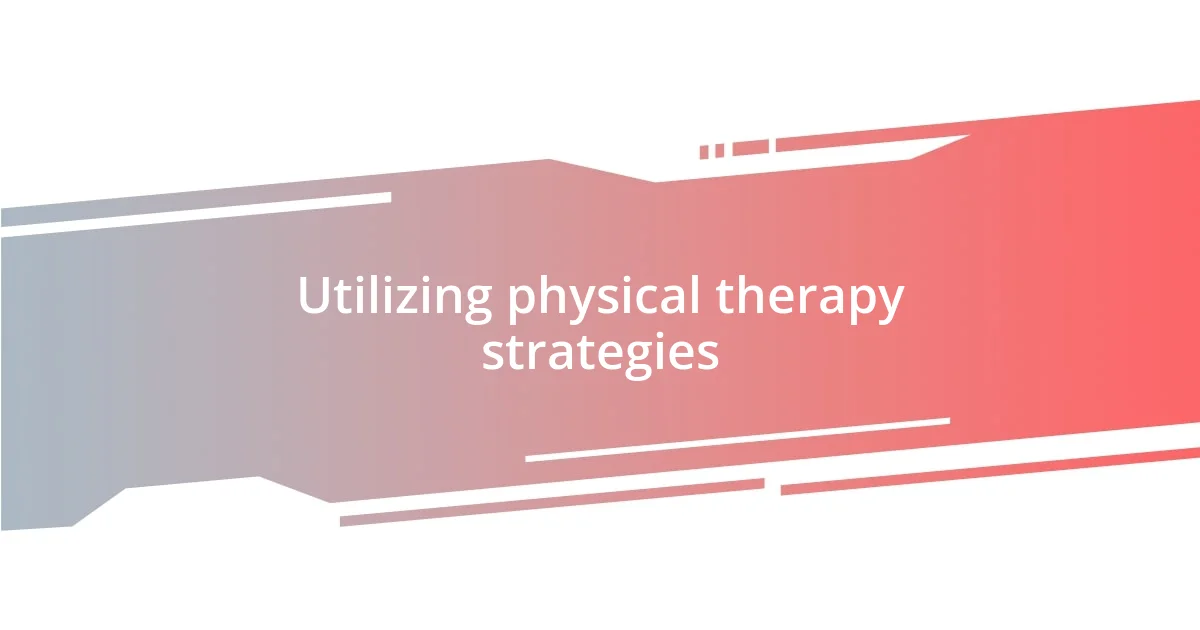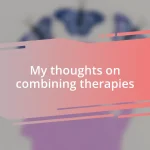Key takeaways:
- Various pain management techniques, such as mindfulness meditation, physical therapy, and non-pharmacological approaches, play crucial roles in alleviating pain and improving quality of life.
- Understanding different pain types—acute, chronic, nociceptive, and neuropathic—helps tailor management strategies effectively by addressing the underlying causes.
- Regularly assessing personal pain levels through quantifiable methods and reflecting on emotional well-being enables a more comprehensive approach to pain management and progress tracking.

Overview of pain management techniques
When we talk about pain management techniques, it’s fascinating to see how varied they can be. I remember attending a workshop on mindfulness meditation, where I discovered how powerful focus and breathing can be in alleviating discomfort. Has anyone else experienced that moment when you channel your attention so deeply that your pain simply fades into the background?
Another technique that caught my attention was physical therapy. I recall the first time I started a regimen; I was skeptical but willing to give it a try. The gradual improvement in my mobility was both encouraging and empowering. Why does it always feel like those small victories make a world of difference in our day-to-day lives?
Medications are, of course, a staple in pain management. I’ve had my share of trial and error with prescriptions, feeling like a lab rat at times. It’s a journey of not just managing pain but also navigating side effects. How do you determine the balance between relief and quality of life? It’s a personal exploration and one that underscores the importance of tailoring pain management to individual needs.

Understanding the types of pain
Understanding the types of pain can be quite enlightening. I’ve come across various categories, but two stand out: acute and chronic pain. Acute pain, like when I sprained my ankle during a weekend hike, often surfaces suddenly and usually has a clear cause. It’s intense at first but subsides as the body heals. In contrast, chronic pain, which I’ve experienced through a back issue, lasts for months or longer, often lingering without a clear reason. It’s like living with a cloud that sometimes gets darker and heavier.
There’s also the distinction between nociceptive and neuropathic pain. Nociceptive pain is typically due to physical damage, like when I accidentally cut my finger while cooking. It’s sharp and immediate, nudging you to react. Meanwhile, neuropathic pain feels different—it’s often described by those who have it as a burning or tingling sensation, stemming from nerve damage. I remember a friend sharing his struggle with diabetic neuropathy, and it made me realize how pain isn’t just about sensation; it can deeply affect someone’s life.
Finally, we can consider the emotional aspect of pain. Pain isn’t only physical—it can trigger feelings of frustration, sadness, and isolation. I’ve noticed that when my back flares up, those emotions can amplify the sensation, making it harder to cope. Understanding these types allows us to approach pain management more effectively, tailoring techniques to the specific pain type we’re encountering.
| Type of Pain | Description |
|---|---|
| Acute Pain | Sudden, intense pain that usually has a clear cause and subsides as the body heals. |
| Chronic Pain | Long-lasting pain that persists for months or longer, often without a clear cause. |
| Nociceptive Pain | Resulting from physical damage to tissues, typically sharp and immediate. |
| Neuropathic Pain | Caused by nerve damage, often described as burning or tingling. |

Evaluating personal pain levels
Evaluating personal pain levels is crucial for effective pain management. I learned early on that quantifying pain can be somewhat subjective, yet vital. I remember when my doctor introduced me to the pain scale—a simple tool that transformed how I communicated my discomfort. It felt empowering to express my experience with numbers and descriptions, shifting from vague complaints to tangible assessments.
Here’s a quick breakdown of how I approach evaluating my pain:
- Pain Scale (1-10): This numerical value helps me articulate intensity.
- Descriptive Words: I often use terms like “sharp,” “dull,” or “throbbing” to describe sensations.
- Duration and Frequency: Tracking how often and how long I feel pain gives insights into patterns.
- Triggers and Relief: Noting what exacerbates or alleviates my pain has guided my management strategies.
- Emotional Impact: Reflecting on how pain affects my mood or motivation has been eye-opening.
Each factor plays a role in creating a fuller picture of my pain. It’s not just about numbers; it’s about understanding how pain interacts with my daily life. This method has not only clarified my experiences but also enhanced my discussions with healthcare providers, allowing me to better tailor my pain management strategies to fit my needs.

Exploring non-pharmacological options
Exploring non-pharmacological options has been a game-changer for me. When I first started dealing with chronic pain, I felt overwhelmed by the idea of relying solely on medications. I remember stumbling upon practices like mindfulness and yoga, which opened my eyes to the mind-body connection. Engaging in these activities not only helped to reduce my pain levels but also brought a sense of calm and clarity that I’d been missing. Have you ever considered how much your mental state can influence your perception of pain? I know for me, a simple 10-minute meditation can turn a tough day around.
Another technique that I found surprisingly effective is warm baths—something I turned to during particularly painful nights. The warmth soothes my aching muscles, and I often lounge with a good book, allowing my mind to drift away from discomfort. It’s a small thing, but that personal ritual has become an essential part of my pain management routine. I can’t emphasize enough how such simple practices can create remarkable shifts. Have you ever tried an activity that seemed trivial but made a significant difference in your well-being?
Lastly, I discovered the power of guided imagery during a particularly stressful episode. Imagining myself in peaceful settings, like lying on a sun-warmed beach, gave me a safe haven to escape to in my mind. It was a powerful reminder that, despite physical limitations, I can still nurture my spirit. Incorporating non-pharmacological options like this enables me to reclaim some control over my pain management, helping me find a little light even on darker days. Isn’t it fascinating how something as simple as visualization can manifest real relief?

Implementing mindfulness and relaxation methods
Mindfulness and relaxation methods have become integral to my pain management journey. I remember when I first approached meditation; it felt foreign yet intriguing. Initially, I’d sit there, thoughts racing, feeling restless. But over time, I learned to embrace that chaos. Just focusing on my breath has made a tangible difference. Have you ever noticed how slowing down can shift your perspective? It’s in those still moments that I rediscover my strength amidst the discomfort.
In addition to meditation, I took up progressive muscle relaxation. This method involves consciously tensing and relaxing various muscle groups. I recall a particularly stressful night; after just a few minutes of this practice, I felt a wave of relief wash over me. It’s remarkable how connecting with my body in this way can dissipate tension and pain. Have you tried to really tune in to how your body feels? Those connections can be illuminating, often revealing hidden stress points that need care.
Finally, I’ve found that practicing gratitude enhances my overall well-being. Each night before bed, I jot down three things I’m thankful for, even when pain clouds my mind. This habit shifts my focus from discomfort to positivity, reminding me of life’s simple joys. It’s fascinating how even in tough moments, fostering a sense of gratitude can uplift me. What small practices have you found to ease your mental load? Finding those pockets of peace in the chaos can create a profound impact on my day-to-day experience with pain.

Utilizing physical therapy strategies
Utilizing physical therapy strategies has been an enlightening aspect of my journey towards pain management. I remember my first physical therapy session like it was yesterday. I was skeptical, thinking that stretching and exercises wouldn’t do much for my chronic pain. To my surprise, I learned customized exercises that not only strengthened my muscles but also improved flexibility. Have you ever walked away from something you were uncertain about, only to find it fundamentally changed your outlook?
One of the most impactful techniques I’ve embraced is the practice of manual therapy. My therapist would use her hands to manipulate my soft tissues, easing tension in a way I had never experienced before. There were days when the pressure felt overwhelming, but slowly, I began to recognize the pain receding. I think that direct touch can transmit comfort and relief; have you ever felt that physical connection and its profound effects on your body?
Additionally, I’ve found that incorporating functional movement patterns into my daily routine is invaluable. I remember fumbling through basic movements at first, like squatting or bending, but now, those very actions feel empowering. Each successful attempt rekindles my confidence, reminding me that progress is achievable. It’s a liberating feeling when your body starts to cooperate with you, isn’t it? These physical therapy strategies have not only helped in managing my pain but in reclaiming my sense of self.

Assessing progress and outcomes
Recognizing progress in pain management can be both uplifting and challenging. I remember attending my monthly follow-ups, sitting there with a mix of hope and apprehension as I tracked my improvement. Each time I shared my experiences and noted changes—even the smallest ones—I felt a sense of empowerment. Have you ever realized how reflecting on your journey can illuminate breakthroughs you might have otherwise overlooked?
Outcomes can be measured in many ways, not just through pain scales or physical capabilities. For me, the moments I celebrated were often found in my emotional resilience. There was a time when I couldn’t think of going for a walk without experiencing dread, yet now, even on my tougher days, I try to step outside and breathe in fresh air. That shift in mindset was nearly as significant as any reduction in pain itself. Isn’t it fascinating how our internal landscape can transform along with our physical experiences?
Ultimately, assessing progress goes beyond numerical values; it’s about connecting dots in how I feel overall. I keep a journal where I reflect on not just physical pain but my mental and emotional state too. When the days seem rough, looking back at my entries often reveals just how far I’ve come. It’s that mix of tracking tangible outcomes and emotional growth that truly paints the picture of my progress. How do you keep tabs on your own journey? Perhaps you’ll find your milestones aren’t just about pain relief, but about thriving in the midst of struggle.















